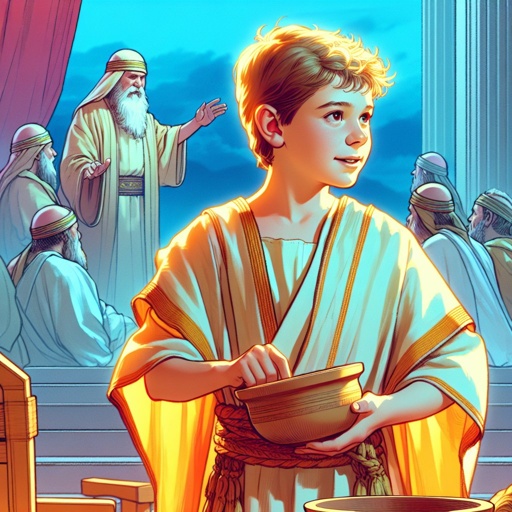2 Samuel 8 Artwork
"And after this it came to pass, that David smote the Philistines, and subdued them: and David took Metheg-ammah out of the hand of the Philistines." - 2 Samuel 8:1
Explore 2 Samuel 8 through paintings, pictures, drawings, digital art, illustrations, wallpapers, photos, prints & more.

2 Samuel 10:8 - "And the children of Ammon came out, and put the battle in array at the entering in of the gate: and the Syrians of Zoba, and of Rehob, and Ish-tob, and Maacah, were by themselves in the field."

1 Samuel 13:8 - "¶ And he tarried seven days, according to the set time that Samuel had appointed: but Samuel came not to Gilgal; and the people were scattered from him."

1 Samuel 8:1 - "And it came to pass, when Samuel was old, that he made his sons judges over Israel."

1 Samuel 8:19 - "¶ Nevertheless the people refused to obey the voice of Samuel; and they said, Nay; but we will have a king over us;"

2 Samuel 15:8 - "For thy servant vowed a vow while I abode at Geshur in Syria, saying, If the LORD shall bring me again indeed to Jerusalem, then I will serve the LORD."

1 Samuel 16:8 - "Then Jesse called Abinadab, and made him pass before Samuel. And he said, Neither hath the LORD chosen this."

2 Samuel 8:2 - "And he smote Moab, and measured them with a line, casting them down to the ground; even with two lines measured he to put to death, and with one full line to keep alive. And so the Moabites became David's servants, and brought gifts."

1 Samuel 8:22 - "And the LORD said to Samuel, Hearken unto their voice, and make them a king. And Samuel said unto the men of Israel, Go ye every man unto his city."

1 Samuel 8:13 - "And he will take your daughters to be confectionaries, and to be cooks, and to be bakers."

2 Samuel 13:8 - "So Tamar went to her brother Amnon's house; and he was laid down. And she took flour, and kneaded it, and made cakes in his sight, and did bake the cakes."

2 Samuel 11:8 - "And David said to Uriah, Go down to thy house, and wash thy feet. And Uriah departed out of the king's house, and there followed him a mess of meat from the king."

1 Samuel 7:8 - "And the children of Israel said to Samuel, Cease not to cry unto the LORD our God for us, that he will save us out of the hand of the Philistines."

1 Samuel 2:18 - "¶ But Samuel ministered before the LORD, being a child, girded with a linen ephod."

1 Samuel 2:26 - "And the child Samuel grew on, and was in favour both with the LORD, and also with men."

2 Samuel 17:8 - "For, said Hushai, thou knowest thy father and his men, that they be mighty men, and they be chafed in their minds, as a bear robbed of her whelps in the field: and thy father is a man of war, and will not lodge with the people."

2 Samuel 4:8 - "And they brought the head of Ish-bosheth unto David to Hebron, and said to the king, Behold the head of Ish-bosheth the son of Saul thine enemy, which sought thy life; and the LORD hath avenged my lord the king this day of Saul, and of his seed."

1 Samuel 8:17 - "He will take the tenth of your sheep: and ye shall be his servants."

2 Samuel 5:8 - "And David said on that day, Whosoever getteth up to the gutter, and smiteth the Jebusites, and the lame and the blind, that are hated of David's soul, he shall be chief and captain. Wherefore they said, The blind and the lame shall not come into the house."

2 Samuel 5:16 - "And Elishama, and Eliada, and Eliphalet."

1 Timothy 2:8

2 Samuel 12:2 - "The rich man had exceeding many flocks and herds:"

2 Samuel 21:8 - "But the king took the two sons of Rizpah the daughter of Aiah, whom she bare unto Saul, Armoni and Mephibosheth; and the five sons of Michal the daughter of Saul, whom she brought up for Adriel the son of Barzillai the Meholathite:"

2 Samuel 19:8 - "Then the king arose, and sat in the gate. And they told unto all the people, saying, Behold, the king doth sit in the gate. And all the people came before the king: for Israel had fled every man to his tent."

2 Samuel 7:8 - "Now therefore so shalt thou say unto my servant David, Thus saith the LORD of hosts, I took thee from the sheepcote, from following the sheep, to be ruler over my people, over Israel:"

1 Samuel 8:7 - "And the LORD said unto Samuel, Hearken unto the voice of the people in all that they say unto thee: for they have not rejected thee, but they have rejected me, that I should not reign over them."

2 Samuel 23:25 - "Shammah the Harodite, Elika the Harodite,"

2 Samuel 23:35 - "Hezrai the Carmelite, Paarai the Arbite,"

2 Samuel 23:27 - "Abiezer the Anethothite, Mebunnai the Hushathite,"

2 Samuel 23:2 - "The Spirit of the LORD spake by me, and his word was in my tongue."

2 Samuel 23:28 - "Zalmon the Ahohite, Maharai the Netophathite,"